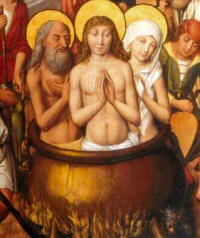Ordinary Time: June 15th
Monday of the Eleventh Week of Ordinary Time
Other Commemorations: St. Vitus, Martyr (RM); St. Germaine Cousin, Virgin (RM); St. Bernard of Montjoux, Priest (RM); St. Luigi Maria Palazzolo, Priest (RM)
» Enjoy our Liturgical Seasons series of e-books!
According to the 1962 Missal of St. John XXIII the Extraordinary Form of the Roman Rite, today is the feast of Sts. Vitus, Modestus and Crescentia. Very little is known of these saints. St. Vitus was martyred in Lucania in South Italy. He is invoked for the cure of epilepsy (St. Vitus' dance).
Historically today is the feast of St. Germain Cousin who was born in Pibrac, France. She was abused as a child and spent her short life as a shepherdess.
St. Vitus
Died c. 303. Unreliable legend has Vitus, the only son of Hylas, a senator in Sicily, become a Christian when he was very young—between the ages of seven and 12— by the influence of the servants who tended him. His Christian tutor, Modestus, and his nurse, Crescentia (wife of Modestus), accompanied him on his journeys throughout Sicily. When his conversions and miracles became widely known to the administrator of Sicily, Valerian, he had Vitus brought before him to shake his faith. (Another version says that his incensed father gave him up to Valerian.) He was unsuccessful, but Vitus with his tutor and nurse fled to Lucania and then to Rome, where he exorcised Emperor Diocletian’s son of an evil spirit.
When Vitus would not sacrifice to the gods his cure was attributed to sorcery. He, Modestus, and Crescentia were subjected to various tortures, including a cauldron of molten lead, from which they emerged unscathed. For example, when throw into the den of a hungry lion, the beast merely licked Vitus affectionately. One version says that the tormentors gave up and freed the trio when during a storm temples were destroyed and an angel guided them back to Lucania, where they eventually died.
The facts are that their cultus is ancient. We are not really even certain about when they lived, although most place their martyrdom at the time of Diocletian. There is even some confusion about the site of their martyrdom. It appears that they may be two separate groups: Vitus alone in Lucania (whose cultus is the oldest), and Vitus, Modestus, and Crescentia in Sicily.
The Vitus who is alone is celebrated in the Gelasian Sacramentary and an early South Italian Book of the Gospels, which assigns to his feast a pericope of the cure from demonic possession and sickness. The Martyrology of Bede and the Old English Martyrology also list Vitus by himself. There is an ancient church dedicated to him on the Esquiline Hill of Rome. Vitus’s relics were moved to Saint-Denis in Paris. A great devotion to Vitus developed in Germany when his relics were translated to Corvey Abbey in Saxony in 836. Most of the medieval abbeys in England celebrated Vitus and Modestus without Crescentia, but five who followed the Sarum Rite added her name.
Saint Vitus is one of the Fourteen Holy Helpers, who, as a group, are especially venerated in France and Germany. The Holy Helpers were believed to possess especially efficacious intercessory power. The relics of Vitus are said to possess many healing properties, especially when epileptics prayed before them (Attwater, Benedictines, Bentley, Delaney, Encyclopedia, Farmer, Husenbeth, Sheppard, White).
—Excerpted from Saints of the Day, Katherine Rabenstein
Patronage: actors; against animal attacks; against dog bites; against lightning; against oversleeping; against storms; against wild beasts; comedians; coppersmiths; Czechoslovakia; dancers; dog bites; dogs; domestic animals; epilepsy; Forio, Italy; lightning; mummers; oversleeping; Prague, Czech Republic; rheumatic chorea; Saint Vitus Dance; snake bites; storms; young people.
Symbols and Representation: Wolf or lion; cockatrice on a book; fire; cock; chained dog; cauldron of boiling oil; palm and cauldron; palm and dog; chalice and dog; sword and dog; sword and rooster.
Often Portrayed as: Boy with a rooster and a cauldron; with saints Modestus and Crescentia; being put in oven; young prince with palm and scepter.
Highlights and Things To Do:
- Read more about Sts. Vitus:
- See the statue of St. Vitus at the St. Peter's Basilica Colonnade.
- Read the biography of St. Vitus by Dom Gueranger.
- This medical excerpt explains the connection between St. Vitus and his dance and the disease of chorea.
- St. Vitus is the patron of Prague, and the cathedral is under his patronage. Visit online St. Vitus Cathedral in Prague. These pages provide a few more delights from the cathedral:
St. Germaine Cousin
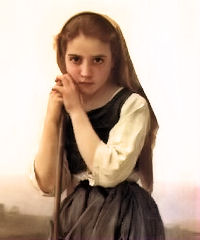 Saint Germaine Cousin was born in 1579 in Pibrac, a small village not far from Toulouse, France. From her earliest years she was a frail, sickly child, and throughout her life was afflicted with scrofula, a tubercular condition affecting particularly the glands of the neck. In addition, her right arm and hand were deformed and partially paralyzed. In spite of her many afflictions, the emaciated child possessed a charming, sweet disposition. Germaine endured not only bodily sufferings, but harsh, cruel treatment from her stepmother, who had a deep aversion for the little girl. The child was almost starved to death and obliged to sleep in the barn on a pile of leaves and twigs under the stairway. At break of day, summer and winter, she would drive the sheep into the fields to graze, then watch them until evening. She had to spin during this time, and if the allotted wool was not spun, she was severely punished.
Saint Germaine Cousin was born in 1579 in Pibrac, a small village not far from Toulouse, France. From her earliest years she was a frail, sickly child, and throughout her life was afflicted with scrofula, a tubercular condition affecting particularly the glands of the neck. In addition, her right arm and hand were deformed and partially paralyzed. In spite of her many afflictions, the emaciated child possessed a charming, sweet disposition. Germaine endured not only bodily sufferings, but harsh, cruel treatment from her stepmother, who had a deep aversion for the little girl. The child was almost starved to death and obliged to sleep in the barn on a pile of leaves and twigs under the stairway. At break of day, summer and winter, she would drive the sheep into the fields to graze, then watch them until evening. She had to spin during this time, and if the allotted wool was not spun, she was severely punished.
The village children, not sharing the hostility of the adults toward this forlorn child, loved to listen to her speak about the goodness and love of God while she guarded her flock. The only instruction Germaine ever received was the catechism taught after Sunday Mass in the village church, which she attended with joy. During the long hours of solitude she spent in the fields and in the stable at night, she remained in sweet communion with God, and never complained of her hard life.
Every morning she was at Mass, and afterwards went to kneel before Our Lady’s shrine. To reach the church she had to cross what was ordinarily a small stream; but after a heavy rain it would become a raging torrent. Several times at those moments, the villagers were amazed to see the rushing waters separate when Germaine approached, and then to watch her cross on dry land. When she left her sheep to go to church, she would place her staff upright in the ground, and the sheep never went far from it. One day the stepmother was seen pursuing Germaine as she drove the sheep down the road. She was accusing the girl of having stolen some bread and concealing it in her apron. When Germaine unfolded her apron, fragrant flowers, foreign to that region, fell to the ground.
Germaine died one night in the year 1601, at the age of twenty-one, and was buried as was the custom in those days, in the village church. Forty-three years later, when a relative was to be buried near her and the stones were removed, the grave-digger found to his amazement, the body of a beautiful young girl in a state of perfect preservation. His pick had struck her nose, and the wound was bleeding. Some of the older residents identified the girl as Germaine Cousin. Miracle after miracle occurred, and in 1867 the neglected little waif of Pibrac was inscribed in the list of Saints by Pope Pius IX. Annually thousands of pilgrims visit the church of Pibrac, where the relics of Saint Germaine are enshrined.
—Excerpted from Heavenly Friends: a Saint for each Day, by Rosalie Marie Levy
Patronage: Victims of abuse and child abuse; abandoned people; against bodily ills; against illness; against impoverishment; against poverty; against sickness; Physically challenged or disabled people; girls from rural areas; handicapped people; loss of parents; peasant girls; shepherdesses; unattractive people; young country/rural girls
Symbols and Representation: girl with a shepherd's crook or with a distaff; girl with flowers in her apron; girl with a sheep or a watchdog; girl with flowers in her apron; peasant girl dying alone in poverty; peasant girl tending sheep; peasant girl with flowers falling around her in winter
Highlights and Things to Do:
- Read more about the life of St. Germaine Cousin:
- Read the book, Germaine: Requiem of a Soul/The True Story of Cinderella, a historical novel about the life of saint Germaine Cousin who was likely the inspiration for the Cinderella fable. Germaine Cousin's life story is however, more wondrous than the fable.
- Her relics are located Basilique Sainte Germain in Pibrac, France. Read more about finding her relics.
St. Bernard of Montjoux
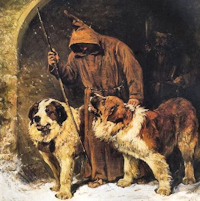 Bernard may have been the son of Count Richard of Menthon. It seems more likely though that he was of Italian birth. Nothing is really known of his parentage and early life.
Bernard may have been the son of Count Richard of Menthon. It seems more likely though that he was of Italian birth. Nothing is really known of his parentage and early life.
Tradition reports that a marriage was being arranged for young Bernard and he fled so as to be free to give his life to God. We do know that he was ordained to the priesthood and that he was appointed Vicar General of the diocese of Aosta, Italy. For approximately forty-two years he traveled throughout the country, visiting the remotest Alpine villages. He would sometimes extend his missionary journeys into the neighboring dioceses of Geneva, Novara and Tarentaise. Bernard had the reputation for enforcing clerical discipline and he built several schools.
He is probably most famous for the hospices he built on the summits of passes over the Alps. Many pilgrims from France and Germany would travel over the Alps on their way to Rome, but it was always a possibility that one would die from freezing along the way. In the 9th century, a system of hospices had been attempted but had lapsed long before Bernard's time. Bernard's hospices in the 11th century were placed under the care of clerics and laymen and were well equipped for the reception of all travelers. Eventually, these caretakers became Augustinians a monastery was built close by, which still exists today
At some point in time, Bernard traveled to Rome to receive formal recognition of the hospices and community and to obtain permission to accept novices. Bernard lived to the age of eighty-five and is believed to have died on May 28, 1081 at St. Lawrence Monastery in Novara, Italy.
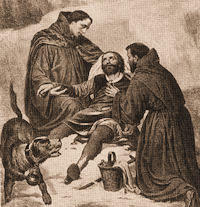 A now-famous breed of dogs, known for its endurance in high altitude and cold, was named in honor of this saint. Bernard's life has been the focus of many romantic plays and stories. Many of us may remember childhood stories of St. Bernard dogs coming to the rescue of stranded or injured victims on Alpine slopes. The dogs almost always seem to have a cask of Brandy attached to their collars and when the victims were revived by a good drink the dogs would lead them to safety.
A now-famous breed of dogs, known for its endurance in high altitude and cold, was named in honor of this saint. Bernard's life has been the focus of many romantic plays and stories. Many of us may remember childhood stories of St. Bernard dogs coming to the rescue of stranded or injured victims on Alpine slopes. The dogs almost always seem to have a cask of Brandy attached to their collars and when the victims were revived by a good drink the dogs would lead them to safety.
However, romance was not what Bernard's life was about. He was strongly committed to the ideals taught by Christ in the Sermon on the Mount. Bernard dedicated his life to bringing the message of Christ to all and to correcting the abuses of clerical life which he saw. He was deeply concerned for the care of the poor and disadvantaged. Living his life in the Alps he knew the dangers present and did what he could to relieve them. He is a model, not of romance, but of deep love and compassion, in imitation of God whom he loved and served with all his heart reprimanded.
—Excerpted from Christ in the Desert
Patronage: Alpinists; mountain climbers; mountaineers; skiers; travelers in the mountains; Alps and the people who live there; Campiglia Cervo, Italy; Menthon, France
Symbols and Representation: Man in a mountain setting holding a bishop's crozier; white dog.
Highlights and Things to Do:
- Read more about St. Bernard:
- Read History of the Grand St Bernard pass for background.
- See more about the The Great Saint Bernard Hospice, Switzerland in Catholic Travel Guide.
- Read about the Saint Bernard Dog. See also The St Bernard: the making of an Alpine legend.
St. Luigi Maria Palazzolo
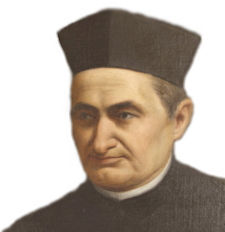 St. Luigi Maria Palazzolo founded the Congregations of the Poverelle Sisters and the Brothers of the Holy Family. Born on December 10, 1827, in Bergamo, the youngest of 9 children, in his mother he found a wise and loving educator.
St. Luigi Maria Palazzolo founded the Congregations of the Poverelle Sisters and the Brothers of the Holy Family. Born on December 10, 1827, in Bergamo, the youngest of 9 children, in his mother he found a wise and loving educator.
After high school, he studied philosophy in the seminary, then theology. On June 23, 1850, he was ordained a priest.
He was a wise educator. He wrote comedy texts with puppets and was able to give a voice to Gioppino, a typical character from Bergamo. He set up night schools for boys and adults, but he was also dedicated to young women. Luigi owned a cottage at Adibi and established the women 's oratory there and placed Teresa Gabrieli, a teacher, at the head of it. She was elected that year (1869) as deputy superior of the Pious Opera of Santa Dorotea. She pronounced the vows of poverty, chastity, and obedience, and swore fidelity to the Pope and conditional dedication to the poor, especially to the youth. In June Don Luigi, on a trip to Rome, felt a strong desire for radical poverty: "It occurred to me that Jesus died naked on the cross, and yet I felt a desire for poverty and to abandon everything...."
Returning to Bergamo, he stripped himself of his possessions in favor of the poor. In the following years, other companions were added to Sister Teresa's surrender; the communities of the Poverelle Sisters (as he called them when he founded them in 1869) continued to expand: first in Vicenza, then in Bergamo, and finally in Brescia. Meanwhile, God had proposed another work to him: a shelter for farmer orphans, entrusting them with the cultivation of the land in the holiday home inherited from his maternal family.
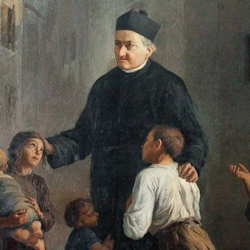 As his number grew, he found in Battista Leidi, the good servant he had in his house, the person capable of carrying out that service out of love of God. Thus the brothers of the Holy Family were born. Towards the end of 1885, his health became precarious. He suffered from cardiac dysfunction to which was added an erysipelas which reduced him to a single sore. He passed away on June 15, 1886, at the age of fifty-eight. At the funeral there was an endless procession of people who prayed and called the deceased a "saint" . The Brothers of the Holy Family died out in 1922, the Poor Sisters continued to serve the poorest in Italy, Africa, and South America. Six of them were killed by the Ebola virus in 1995: Floralba Rondi, Clarangela Ghilardi, Danielangela Sorti, Dinaro sa Belleri, Annelvira Ossoli and Vitarosa Zorza are all venerable.
As his number grew, he found in Battista Leidi, the good servant he had in his house, the person capable of carrying out that service out of love of God. Thus the brothers of the Holy Family were born. Towards the end of 1885, his health became precarious. He suffered from cardiac dysfunction to which was added an erysipelas which reduced him to a single sore. He passed away on June 15, 1886, at the age of fifty-eight. At the funeral there was an endless procession of people who prayed and called the deceased a "saint" . The Brothers of the Holy Family died out in 1922, the Poor Sisters continued to serve the poorest in Italy, Africa, and South America. Six of them were killed by the Ebola virus in 1995: Floralba Rondi, Clarangela Ghilardi, Danielangela Sorti, Dinaro sa Belleri, Annelvira Ossoli and Vitarosa Zorza are all venerable.
—Excepted from Famiglia Cristiana
Highlights and Things to Do:
- Read more about St. Luigi:
- SL Media
- catholicSaints.info, especially for the Italian sites (which can be translated).
- Watch this short video from Gloria TV about St. Luigi's life.
- Read about the heroic Sisters of the Poverelle who died of ebola in the service of the poor.


